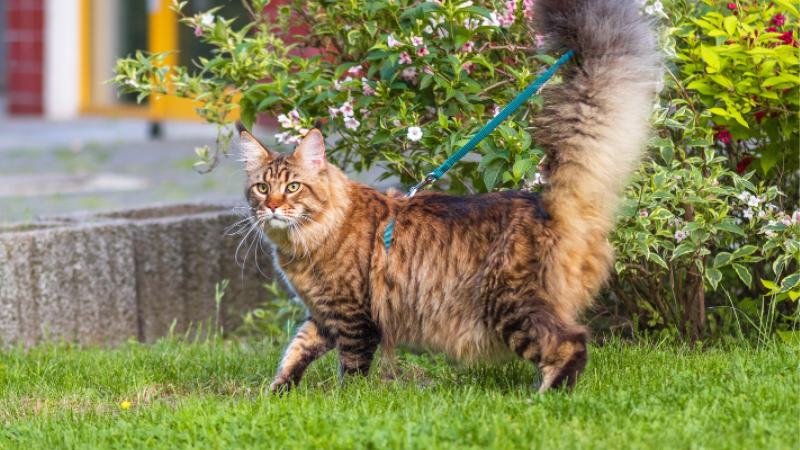
As a veterinarian and behaviourist, I spend a lot of my day talking about the emotional and physical needs and desires of cats and dogs. A big topic of conversation among my colleagues and clients revolves around the pros and cons of letting cats have time outdoors.
Unfortunately, many people let their cat’s go outside without taking important factors into consideration. However, there are things you can do to make the outdoors fun and safe for your cat.
If you’re wondering how to prepare your cat for the outdoors, or if you should let them out at all, keep reading!
Indoor vs. Outdoor: The Pros and Cons
There are a few things we know about indoor vs. outdoor cats that can help us make best the decisions for our kitties.
How long do indoor cats live?
Indoor cats live longer. While many indoor cats can reach their teenage years, strictly outdoor cats have an average lifespan of two to five years.
Indoor Health Concerns
Indoor cats are prone to obesity due to free feeding and offering treats in response to their meowing. Outdoor cats are less likely to be overweight, as they spend time exploring their territory and actively hunting – whether they consumer their prey or not.
Outdoor cat lifespans
Outdoor cats are more likely to face trauma. They can be attacked by another animal or get hit by a vehicle, which can lead to serious injuries and death. They are also at risk for infectious diseases such as feline infectious leukemia (FeLV) or feline immunodeficiency virus (FIV), which is spread by fighting with other cats.
Outdoor Cat Health Concerns
Outdoor cats can carry external and internal parasites like fleas and intestinal worms which require more frequent parasite control to stay healthy. Indoor cats have fewer opportunities to become infected because they are not hunting or spending time with unfamiliar cats.
How to keep your indoor cat happy
1. Ensure that cats have enough space – horizontal and vertical
Cats need room to stalk their toys, but open floors are not enough. Look to provide vertical space with tall kitty condos, doorjamb hammocks, and wall shelving. Give your cat hiding spaces in cardboard boxes, pet tents, and closets.
2. Keep the litter box clean and away from food dishes
Many cats are fastidious about their indoor litter box habits and generally prefer clumping litter. Cleaning the dirty clumps daily and changing the litter once or twice a week is essential.
You may need to clean more often if there are multiple cats in the home.
3. Feed your cat at set mealtimes
Veterinarians recommend two meals per day consisting of canned food with dry dental kibble or treats to keep teeth clean.
If you have a cat that wakes you up in the middle of the night for a snack, offer canned food at bedtime or use a food dispenser with a timer to avoid sleep interruptions.
Take treats into account when calculating daily calories to avoid overfeeding.
4. Exercise your cat
Yep, you heard me. Cats who engage in play, either by themselves, other family pets, or their owners, will be healthier than their sedentary counterparts.
Cats have individual preferences for toys, so figure out what encourages your cat to hop off the couch. If they are reluctant to play, consider moving your cat from their resting place to another spot in the house just to get them moving.
Only have a few toys out at a time and rotate them every week or two to keep play time fresh.
5. What if my indoor cat wants to go outside?
Whether you leash-train your kitty or build a full-sized catio, see if your cat enjoys time outdoors to roll around in the grass, hunt bugs, and sun themselves. If leashing your cat, fit them with a harness instead of a collar.
However, some cats become overwhelmed by outside noises, so it is best to keep them indoors.
Should I let my cat outside?
Well, it depends. Cats who spend time outdoors have special health and wellness needs. All cats should properly be identifiable with a microchip in case they get lost. Tattoos and break-away collars are great back-ups but are not reliable primary forms of identification. If you do decide to let your cat outdoors, a veterinarian should examine them at least once a year to keep rabies vaccinations up to date, and ensure parasite control.
Recommendations for vaccinations and other precautions will depend on your neighbourhood, season, and kitty hunting habits. Whether or not your cat cab be outdoors without supervision is a decision only you can make. No matter what, the best thing you can do for your cat before letting them go outdoors is talk to your vet to fully understand the risks first.
Pet insurance can help with the cost of vet visits
Accidents and illnesses related to outdoor living may be eligible for coverage. Costs related to vaccines and wellness care are available. Learn what’s covered by Petsecure and get a free quote today.
